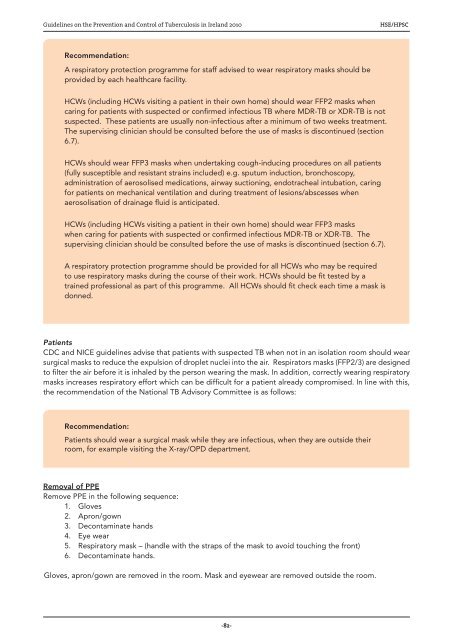Guidelines on the Prevention and Control of Tuberculosis in Ireland
Guidelines on the Prevention and Control of Tuberculosis in Ireland
Guidelines on the Prevention and Control of Tuberculosis in Ireland
Create successful ePaper yourself
Turn your PDF publications into a flip-book with our unique Google optimized e-Paper software.
<str<strong>on</strong>g>Guidel<strong>in</strong>es</str<strong>on</strong>g> <strong>on</strong> <strong>the</strong> Preventi<strong>on</strong> <strong>and</strong> C<strong>on</strong>trol <strong>of</strong> <strong>Tuberculosis</strong> <strong>in</strong> Irel<strong>and</strong> 2010HSE/HPSCRecommendati<strong>on</strong>:A respiratory protecti<strong>on</strong> programme for staff advised to wear respiratory masks should beprovided by each healthcare facility.HCWs (<strong>in</strong>clud<strong>in</strong>g HCWs visit<strong>in</strong>g a patient <strong>in</strong> <strong>the</strong>ir own home) should wear FFP2 masks whencar<strong>in</strong>g for patients with suspected or c<strong>on</strong>firmed <strong>in</strong>fectious TB where MDR-TB or XDR-TB is notsuspected. These patients are usually n<strong>on</strong>-<strong>in</strong>fectious after a m<strong>in</strong>imum <strong>of</strong> two weeks treatment.The supervis<strong>in</strong>g cl<strong>in</strong>ician should be c<strong>on</strong>sulted before <strong>the</strong> use <strong>of</strong> masks is disc<strong>on</strong>t<strong>in</strong>ued (secti<strong>on</strong>6.7).HCWs should wear FFP3 masks when undertak<strong>in</strong>g cough-<strong>in</strong>duc<strong>in</strong>g procedures <strong>on</strong> all patients(fully susceptible <strong>and</strong> resistant stra<strong>in</strong>s <strong>in</strong>cluded) e.g. sputum <strong>in</strong>ducti<strong>on</strong>, br<strong>on</strong>choscopy,adm<strong>in</strong>istrati<strong>on</strong> <strong>of</strong> aerosolised medicati<strong>on</strong>s, airway sucti<strong>on</strong><strong>in</strong>g, endotracheal <strong>in</strong>tubati<strong>on</strong>, car<strong>in</strong>gfor patients <strong>on</strong> mechanical ventilati<strong>on</strong> <strong>and</strong> dur<strong>in</strong>g treatment <strong>of</strong> lesi<strong>on</strong>s/abscesses whenaerosolisati<strong>on</strong> <strong>of</strong> dra<strong>in</strong>age fluid is anticipated.HCWs (<strong>in</strong>clud<strong>in</strong>g HCWs visit<strong>in</strong>g a patient <strong>in</strong> <strong>the</strong>ir own home) should wear FFP3 maskswhen car<strong>in</strong>g for patients with suspected or c<strong>on</strong>firmed <strong>in</strong>fectious MDR-TB or XDR-TB. Thesupervis<strong>in</strong>g cl<strong>in</strong>ician should be c<strong>on</strong>sulted before <strong>the</strong> use <strong>of</strong> masks is disc<strong>on</strong>t<strong>in</strong>ued (secti<strong>on</strong> 6.7).A respiratory protecti<strong>on</strong> programme should be provided for all HCWs who may be requiredto use respiratory masks dur<strong>in</strong>g <strong>the</strong> course <strong>of</strong> <strong>the</strong>ir work. HCWs should be fit tested by atra<strong>in</strong>ed pr<strong>of</strong>essi<strong>on</strong>al as part <strong>of</strong> this programme. All HCWs should fit check each time a mask isd<strong>on</strong>ned.PatientsCDC <strong>and</strong> NICE guidel<strong>in</strong>es advise that patients with suspected TB when not <strong>in</strong> an isolati<strong>on</strong> room should wearsurgical masks to reduce <strong>the</strong> expulsi<strong>on</strong> <strong>of</strong> droplet nuclei <strong>in</strong>to <strong>the</strong> air. Respirators masks (FFP2/3) are designedto filter <strong>the</strong> air before it is <strong>in</strong>haled by <strong>the</strong> pers<strong>on</strong> wear<strong>in</strong>g <strong>the</strong> mask. In additi<strong>on</strong>, correctly wear<strong>in</strong>g respiratorymasks <strong>in</strong>creases respiratory effort which can be difficult for a patient already compromised. In l<strong>in</strong>e with this,<strong>the</strong> recommendati<strong>on</strong> <strong>of</strong> <strong>the</strong> Nati<strong>on</strong>al TB Advisory Committee is as follows:Recommendati<strong>on</strong>:Patients should wear a surgical mask while <strong>the</strong>y are <strong>in</strong>fectious, when <strong>the</strong>y are outside <strong>the</strong>irroom, for example visit<strong>in</strong>g <strong>the</strong> X-ray/OPD department.Removal <strong>of</strong> PPERemove PPE <strong>in</strong> <strong>the</strong> follow<strong>in</strong>g sequence:1. Gloves2. Apr<strong>on</strong>/gown3. Dec<strong>on</strong>tam<strong>in</strong>ate h<strong>and</strong>s4. Eye wear5. Respiratory mask – (h<strong>and</strong>le with <strong>the</strong> straps <strong>of</strong> <strong>the</strong> mask to avoid touch<strong>in</strong>g <strong>the</strong> fr<strong>on</strong>t)6. Dec<strong>on</strong>tam<strong>in</strong>ate h<strong>and</strong>s.Gloves, apr<strong>on</strong>/gown are removed <strong>in</strong> <strong>the</strong> room. Mask <strong>and</strong> eyewear are removed outside <strong>the</strong> room.-82-
















